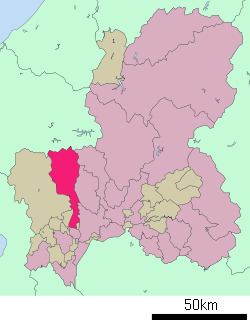Local time Monday 2:55 AM | Website www.city.motosu.lg.jp | |
 | ||
Weather 3°C, Wind NW at 3 km/h, 91% Humidity Points of interest Neodani Fault, Monjunomori Park, Sakura Museum | ||
Motosu (本巣市, Motosu-shi) is a city in the south west of Gifu Prefecture, Japan.
Contents
Map of Motosu, Gifu Prefecture, Japan
As of July 2011, the city has an estimated population of 34,997 and a population density of 93 persons per km2. The total area is 374.57 km2.
History
On October 28, 1891, the Mino-Owari earthquake, the second largest earthquake to hit Japan, struck. Its epicenter was located in Motosu.
The modern city of Motosu was established on February 1, 2004, from the merger of the former town of Motosu, absorbing the towns of Itonuki and Shinsei, and the village of Neo (all from Motosu District). The city's name came from Motosu District.
On April 29, 2006, Malera Gifu opened on Mitsuhashi, one of the main roads of Motosu. This shopping centre covers an area of 185,000 m2, making it one of the largest shopping centres in Japan. It houses approximately 240 retail outlets, including a supermarket (Valor), restaurants, clothes retailers and a cinema (Toho Cinema).
City symbols
Like many other cities in Japan, Motosu has a tree, a flower, a fish and a bird that are associated with the city.
Motosu city's tree is the persimmon tree, which is found growing naturally in the mountainous areas of Motosu. As persimmons are also cultivated in Motosu, it was chosen to represent the agricultural industry in the area.
The city flower is the usuzumi cherry blossom found in the recently merged Neo. This unique cherry blossom initially sprouts pale pink flowers, which become white in full bloom, and a light black colour when the flowers die. Neo is also home to one of the three largest cherry blossom trees in Japan, which is reported to be the oldest cherry blossom tree in Japan.
Ayu or sweetfish, has been chosen to be the representative fish of the city. Known as "the queen of clear streams", the fish is found in the Neo River that flows through Motosu. Highly regarded for its flavour in Japan, it is fished throughout summer in the rivers.
The Motosu city bird is the uguisu sparrow, found in shrub thickets throughout Motosu. The sparrow is known for its greenish brown colouring on its back, and white belly. Female birds can also be recognised by their dash pattern on their backs. It is also known as the bush warbler or "flower-viewing" bird, for its appearance near the many cherry blossom trees in the area.
City song
In order to commemorate the three-year anniversary Motosu-city's amalgamation of Itonuki, Neo, Shinsei and Motosu, the municipal government began working on a theme song that best represented their vision of the future. The lyrics of the theme song, "Habataite", are intended to convey the ideas of nature and people living harmoniously together. The song is played every afternoon on the loudspeakers to warn children to return home before nightfall.
The music was written by the world-renowned ocarina player Soujirou, who was commissioned by the local city government to write the theme song.
Education
National Institutes:
Private schools:
